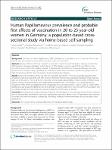Human Papillomavirus prevalence and probable first effects of vaccination in 20 to 25 year-old women in Germany: a population-based cross-sectional study via home-based self-sampling
Deleré, Yvonne
Remschmidt, Cornelius
Leuschner, Josefine
Schuster, Melanie
Fesenfeld, Michaela
Schneider, Achim
Wichmann, Ole
Kaufmann, Andreas M.
Background: Estimates of Human Papillomavirus (HPV) prevalence in a population prior to and after HPV vaccine introduction are essential to evaluate the short-term impact of vaccination. Methods: Between 2010 and 2012 we conducted a population-based cross-sectional study in Germany to determine HPV prevalence, genotype distribution and risk factors for HPV-infection in women aged 20-25 years. Women were recruited by a two-step cluster sampling approach. A home-based self-collection of cervicovaginal lavages was used. Specimens were analysed using a general primer GP5+/GP6+-based polymerase chain reaction and genotyped for 18 high-risk and 6 low-risk HPV- strains by Luminex-based multiplexed genotyping. Results: Among 787 included women, 512 were not vaccinated against HPV. In the non-vaccinated population, HPV prevalence of any type was 38.1%, with HPV 16 (19.5%) being the most prevalent genotype. Prevalence of any high-risk type was 34.4%, and in 17.4% of all women, more than one genotype was identified. A higher number of lifetime sexual partners and low educational status were independently associated with HPV-infection. In 223 vaccinated women, prevalence of HPV 16/18 was significantly lower compared to non-vaccinated women (13.9% vs. 22.5%, p = 0.007). When stratifying by age groups, this difference was only significant in women aged 20-21 years, who at time of vaccination were on average younger and had less previous sexual contacts than women aged 22-25 years. Conclusion: We demonstrate a high prevalence of high-risk HPV genotypes in non-vaccinated women living in Germany that can be potentially prevented by vaccination. Probable first vaccination effects on the HPV prevalence were observed in women who were vaccinated at younger age. This finding reinforces the recommendation to vaccinate girls in early adolescence.
No license information

